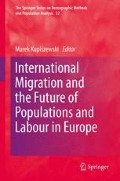Abstract
This chapter looks predominantly at the possible role migration might play in containing ageing of European populations. We present selected results of simulations of migration flows from outside the system of 27 countries which would be hypothetically needed to maintain the sizes and structures of the populations under study. Various simulations are subsequently compared from the point of view of their plausibility and the impact of different assumptions on counteracting the negative economic effects of population ageing. The outcome of the analysis is compared with the outcomes of similar studies.
The simulations we conducted show clearly that the long-term consequences of demographic change should be treated with due attention by social policy makers and politicians. The changes in social policies, aiming at increasing labour force participation and reconciling it with support for childbearing, as well as reforms of pension systems, are at the core of the strategies to adapt social and economic systems to the new and unavoidable demographic patterns.
Access this chapter
Tax calculation will be finalised at checkout
Purchases are for personal use only
Notes
References
Andersson, G. (2003). Childbearing developments in Denmark, Norway, and Sweden from the 1970s to the 1990s: A comparison (MPIDR Working Paper 2003–036). Rostock.
Bijak, J., Kicinger, A., Kupiszewska, D., & Kupiszewski, M. (2008a). Long-term international migration scenarios for Europe, 2002–2052. In C. Bonifazi, M. Okólski, J. Schoorl, & P. Simon (Eds.), International migration in Europe: New trends, new methods of analysis (IMISCOE Research Series, pp. 129–151). Amsterdam: Amsterdam University Press.
Bijak, J., Kupiszewska, D., & Kupiszewski, M. (2008b). Replacement migration revisited: Simlations of the effects of selected population and labor market strategies for the ageing Europe, 2002–2052. Population Research and Policy Review, 27(3), 321–342.
Bouvier, L. F. (2001). Replacement migration: Is it a solution to declining and aging populations? Population and Environment, 22(4), 377–381.
Burke, B. M. (1997, July). Uncoupling growth from prosperity: The U.S. versus Japan. Alexandria: NPG Footnote, Negative Population Growth.
Coleman, D. A. (2002). Replacement migration, or why everyone is going to have to live in Korea: A fable for our times from the United Nations. Philosophical Transactions of the Royal Society B, 357(1420), 583–598.
Espenshade, T. J. (2001). “Replacement migration” from the perspective of equilibrium stationary populations. Population and Environment, 22(4), 383–400.
Espenshade, T. J., Bouvier, L. F., & Arthur, W. B. (1982). Immigration and the stable population model. Demography, 19(1), 125–133.
Feld, S. (2000). Active population growth and immigration hypotheses in Western Europe. European Journal of Population, 16(1), 3–40.
Gauthier, A. (2007). The impact of family policies on fertility in industrialised countries: A review of the literature. Population and Development Review, 26(3), 323–346.
International Labour Organization. (2003). LABORSTA database on labour statistics. http://laborsta.ilo.org
Lesthaeghe, R., & van de Kaa, D. J. (1986). Twee demografische transities? In D. J. van de Kaa & R. Lesthaeghe (Eds.), Bevolking: Groei en Krimp (pp. 9–24). Deventer: Van Loghum Slaterus.
Lotka, A. J. (1907). Relation between birth rates and death rates. Science, 26(653), 21–22.
McDonald, P., & Kippen, R. (1999, March 18–19). Ageing: The social and demographic dimensions. In Productivity Commission (Ed.), Policy implications of the ageing of Australia’s population (pp. 47–70). Conference Proceedings, Melbourne.
McDonald, P., & Kippen, R. (2000, March 23–25). The implications of below replacement fertility for labour supply and international migration, 2000–2050. Paper presented to the 2000 Annual Meeting of the Population Association of America, Los Angeles.
National Research Council. (2001). Preparing for an aging world: The case for cross-national research. Washington, DC: National Academy Press.
Pollard, J. H. (1973). Mathematical models for the growth of human populations. Cambridge: Cambridge University Press.
Roseveare, D., Leibniz, W., Fore, D., & Wurzel, A. (1996). Ageing populations, pensions systems and government budgets: Simulations for 20 OECD countries (Economics Department Working Papers 168). OECD: Paris.
Speidel, J. J., Weiss, D. C., Ethelston, S. A., & Gilbert, S. M. (2009). Population policies, programmes and the environment. Philosophical Transactions of the Royal Society B, 364(1532), 3049–3065.
United Nations. (2000). Replacement migration: Is it a solution to declining and ageing populations? New York: United Nations Population Division.
United Nations. (2002). World population ageing: 1950–2050. New York: United Nations Population Division.
United Nations. (2003a). World population prospects: 2002 revision. New York/Geneva: United Nations.
United Nations. (2003b). UN ECE economic survey of Europe, No. 2. New York: United Nations Economic Commission for Europe.
World Bank. (2003). 2003 world development indicators CD-ROM. World Bank.
Wu, Z., & Li, N. (2003). Immigration and the dependency ratio of a host population. Mathematical Population Studies, 10(1), 21–39.
Author information
Authors and Affiliations
Editor information
Editors and Affiliations
Rights and permissions
Copyright information
© 2013 Springer Science+Business Media Dordrecht.
About this chapter
Cite this chapter
Bijak, J., Kupiszewska, D., Kupiszewski, M., Saczuk, K. (2013). Population Ageing, Population Decline and Replacement Migration in Europe. In: Kupiszewski, M. (eds) International Migration and the Future of Populations and Labour in Europe. The Springer Series on Demographic Methods and Population Analysis, vol 32. Springer, Dordrecht. https://doi.org/10.1007/978-90-481-8948-9_14
Download citation
DOI: https://doi.org/10.1007/978-90-481-8948-9_14
Published:
Publisher Name: Springer, Dordrecht
Print ISBN: 978-90-481-8947-2
Online ISBN: 978-90-481-8948-9
eBook Packages: Humanities, Social Sciences and LawSocial Sciences (R0)

